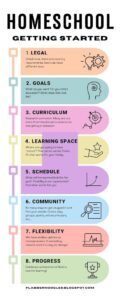As a seasoned homeschool mom, I understand how overwhelming the idea of homeschooling can be at first. But trust me, it’s one of the most rewarding decisions you can make for your family. You can do it!
If you’re considering homeschooling or just starting out, here’s a summary of the key steps to help you feel confident and prepared.
1. understand the legal requirements
Each state or country has specific homeschooling laws.
Start by researching the laws in your area, including registration, required
subjects, and annual assessments. This ensures you’re on the right track from
the start.
2. set your homeschooling goals
Think about what you want for your child’s education.
Do you want a traditional approach or something more flexible and
interest-based? Things to keep in mind as you move forward. Defining your
goals will guide your curriculum choice and teaching style.
3. choose curriculum
There are countless homeschooling curricula out there,
from traditional boxed sets to online programs and more eclectic, child-led
methods. Consider your child’s learning style, your family’s values, and your
lifestyle when choosing.
For example, do they do well with hands-on activities
or prefer listening to instruction versus reading? It’s perfectly fine to
mix and match different resources!
4. create a learning space
Where is a good spot for learning?
Some that come to mind…
· The
kitchen table.
· The
sofa.
· The
playroom (easy way to incorporate learning with play!)
· A
homeschool room
· Whatever
works for you and your family!
Designating a specific area in your home for
schoolwork can be great for many reasons. Whether it’s a room or a corner of
the living room, having a spot for schooling things to land is always a good
idea.
The space doesn’t need to be elaborate, just a place
where your child can focus, and you can easily access teaching materials.
5. build a schedule that works for your family
One of the biggest perks of homeschooling is
flexibility, but that doesn’t mean a routine isn’t important. Create a daily
schedule that suits your family’s rhythms, allowing for breaks, outdoor time,
and hands-on learning.
6. join a homeschooling community
Whether it’s online or in person, connecting with
other homeschool families is invaluable. You’ll gain support, ideas, and social
opportunities for your children.
Local co-ops, field trips, and activities also help
make the homeschooling experience richer.
Plus, it’s lots of fun to connect with other
homeschooling families!
7. be flexible and patient
Homeschooling is a journey, not a race. Don’t be
afraid to adjust your plans if something isn’t working. It’s okay to toss that
curriculum that is not working mid-year and try something else.
Give yourself grace as you learn alongside your children. It’s okay to have
challenges — they’re all part of the process!
8. track progress and celebrate achievements
While homeschooling can be informal, tracking your
child’s progress will help you stay on top of their development. Some states
require record keeping as well.
Celebrate both big and small achievements to keep your
child motivated (and yourself!) and to build their love for learning.
Starting homeschooling might feel daunting, but with
careful planning, flexibility, and a supportive community, it can become a
deeply enriching experience for you and your child.
Remember, there’s no one-size-fits-all approach. Trust
your instincts, and don’t be afraid to adapt as you go. The most important
thing is that your child is learning and thriving in an environment you’ve
tailored to their needs.
You can do this!! Happy homeschooling!


















